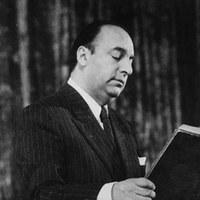Parral, 1904 – Santiago (Chile), 1973
By Flávio Aguiar
With the publication of Veinte poemas de amor, by Neftalí Ricardo Reyes Basualto, or Pablo Neruda, in 1924, Hispanic Latin American poetry took a definitive leap into the 20th century. Released under the inspiration of the contemporary, the Chilean poet’s second work received great popular acceptance and projected him into a unique place in the poetic scene of the Americas. The stature of the writer, who dedicated himself to translations and theater works (such as Fulgor y muerte de Joaquín Murieta, 1967), is compared to “that of a poetic planet.”
His literary trajectory reconciled distinct periods of creation, which shows the different facets of his poetic work: one focused on love, the most popular; another centered on the political, on social causes, the poor, and the workers; and the third based on the awareness of intimacy. The informal vocabulary, drawn from the everyday experiences of adolescence and used in the set of the first twenty poems, gave way to the epic poem Canto general (1950), a tone that brings him closer to many of the creations of Brazilian poet Carlos Drummond de Andrade.
After twelve years of dedication to his writing, which began in 1938, he constructed a vast mural of the Hispanic-American continent under the triple perspective of the earth, history, and humanity. His 15,000 verses sing of the injustice and pain that weigh upon the Latin American being, of which the writer intentionally became the spokesperson, even recording numerous acts of violence committed against the people, including, among others, the murder of Olga Benário, the companion of the communist revolutionary Luiz Carlos Prestes.
His involvement in politics went from militancy and joining the Communist Party to the position of senator. He lived in exile during the government of Gabriel González Videla and engaged in numerous controversies, such as the one with Mexican poet Octavio Paz, when he stated that “any creation that is not in the service of freedom in these days of total threat is a betrayal.”

Political actions also supported many of his travels. His visit to the former Soviet Union, China, and other socialist countries during the Cold War was the theme for another book, Las uvas y el viento (1954), and motivated interactions with intellectuals from different generations, such as the Spaniards Federico García Lorca, Rafael Alberti, and the Brazilian Vinicius de Moraes, among many others. He maintained a broad range of cultural activities.
In his country, he founded and directed the magazine La Gaceta de Chile in 1955. In Spain, he was responsible for the publication Caballo verde para la poesía (1938).
When he received the Nobel Prize in 1971, he was a politically established author − or a “poet of public utility,” as he called himself. He also wove into his work the paradoxes of the human condition, dealing with loneliness and solidarity, subjectivity and ideology.
His work is vast, gathered in about forty volumes dedicated solely to his poetic creations. Similarly, the list of awards he received throughout his life is extensive, including the Viareggio-Versilia, established in 1966, granted to individuals dedicated to culture and the promotion of understanding between peoples.
He was one of the poets who continued the work of Gabriela Mistral, forming a paradigmatic reference for Latin American poetry and influencing generations of writers from this and other continents, as attested by the excellent Chilean poet Gonzalo Rojas (Cervantes Prize, 2004). Other works: Residencia en la tierra (1935); España en el corazón (1938); Memorial de Isla Negra (1964); Geografía infructuosa (1972); Confieso que he vivido (1974).



